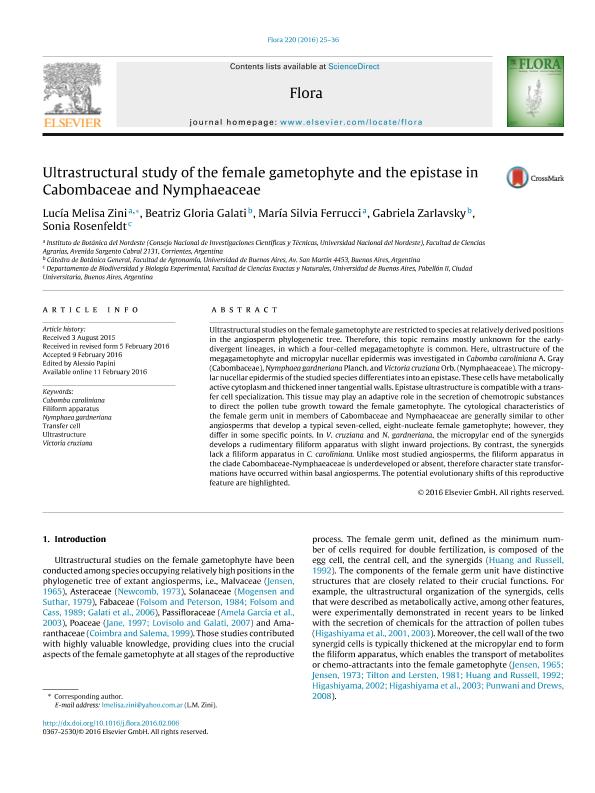Mostrar el registro sencillo del ítem
dc.contributor.author
Zini, Lucia Melisa

dc.contributor.author
Galati, Beatriz Gloria

dc.contributor.author
Ferrucci, María Silvia

dc.contributor.author
Zarlavsky, Gabriela Elena

dc.contributor.author
Rosenfeldt, Sonia

dc.date.available
2017-09-25T19:42:04Z
dc.date.issued
2016-02
dc.identifier.citation
Zini, Lucia Melisa; Galati, Beatriz Gloria; Ferrucci, María Silvia; Zarlavsky, Gabriela Elena; Rosenfeldt, Sonia; Ultrastructural study of the female gametophyte and the epistase in Cabombaceae and Nymphaeaceae; Elsevier Gmbh; Flora; 220; 2-2016; 25-36
dc.identifier.issn
0367-2530
dc.identifier.uri
http://hdl.handle.net/11336/25074
dc.description.abstract
Ultrastructural studies on the female gametophyte are restricted to species at relatively derived positionsin the angiosperm phylogenetic tree. Therefore, this topic remains mostly unknown for the early-divergent lineages, in which a four-celled megagametophyte is common. Here, ultrastructure of themegagametophyte and micropylar nucellar epidermis was investigated in Cabomba caroliniana A. Gray(Cabombaceae), Nymphaea gardneriana Planch. and Victoria cruziana Orb. (Nymphaeaceae). The micropy-lar nucellar epidermis of the studied species differentiates into an epistase. These cells have metabolicallyactive cytoplasm and thickened inner tangential walls. Epistase ultrastructure is compatible with a trans-fer cell specialization. This tissue may play an adaptive role in the secretion of chemotropic substancesto direct the pollen tube growth toward the female gametophyte. The cytological characteristics ofthe female germ unit in members of Cabombaceae and Nymphaeaceae are generally similar to otherangiosperms that develop a typical seven-celled, eight-nucleate female gametophyte; however, theydiffer in some specific points. In V. cruziana and N. gardneriana, the micropylar end of the synergidsdevelops a rudimentary filiform apparatus with slight inward projections. By contrast, the synergidslack a filiform apparatus in C. caroliniana. Unlike most studied angiosperms, the filiform apparatus inthe clade Cabombaceae-Nymphaeaceae is underdeveloped or absent, therefore character state transfor-mations have occurred within basal angiosperms. The potential evolutionary shifts of this reproductivefeature are highlighted.
dc.format
application/pdf
dc.language.iso
eng
dc.publisher
Elsevier Gmbh

dc.rights
info:eu-repo/semantics/openAccess
dc.rights.uri
https://creativecommons.org/licenses/by-nc-sa/2.5/ar/
dc.subject
Cabomba Caroliniana
dc.subject
Filiform Apparatus
dc.subject
Nymphaea Gardneriana
dc.subject
Transfer Cell
dc.subject.classification
Bioquímica y Biología Molecular

dc.subject.classification
Ciencias Biológicas

dc.subject.classification
CIENCIAS NATURALES Y EXACTAS

dc.title
Ultrastructural study of the female gametophyte and the epistase in Cabombaceae and Nymphaeaceae
dc.type
info:eu-repo/semantics/article
dc.type
info:ar-repo/semantics/artículo
dc.type
info:eu-repo/semantics/publishedVersion
dc.date.updated
2017-08-24T18:57:38Z
dc.journal.volume
220
dc.journal.pagination
25-36
dc.journal.pais
Alemania

dc.journal.ciudad
Berlín
dc.description.fil
Fil: Zini, Lucia Melisa. Consejo Nacional de Investigaciones Científicas y Técnicas. Centro Científico Tecnológico Conicet - Nordeste. Instituto de Botánica del Nordeste. Universidad Nacional del Nordeste. Facultad de Ciencias Agrarias. Instituto de Botánica del Nordeste; Argentina
dc.description.fil
Fil: Galati, Beatriz Gloria. Universidad de Buenos Aires. Facultad de Agronomia; Argentina
dc.description.fil
Fil: Ferrucci, MarÍa Silvia. Consejo Nacional de Investigaciones Científicas y Técnicas. Centro Científico Tecnológico Conicet - Nordeste. Instituto de Botánica del Nordeste. Universidad Nacional del Nordeste. Facultad de Ciencias Agrarias. Instituto de Botánica del Nordeste; Argentina
dc.description.fil
Fil: Zarlavsky, Gabriela Elena. Universidad de Buenos Aires. Facultad de Agronomia; Argentina
dc.description.fil
Fil: Rosenfeldt, Sonia. Universidad de Buenos Aires; Argentina
dc.journal.title
Flora

dc.relation.alternativeid
info:eu-repo/semantics/altIdentifier/doi/http://dx.doi.org/10.1016/j.flora.2016.02.006
dc.relation.alternativeid
info:eu-repo/semantics/altIdentifier/url/http://www.sciencedirect.com/science/article/pii/S0367253016300160
Archivos asociados
